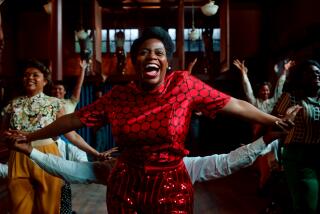MOVIE REVIEW : A FRESH LOOK AT ‘LADY AND THE TRAMP’
Thirty-one years after its premiere, Walt Disney’s “Lady and the Tramp” (in re-release, citywide) seems newer and fresher than Don Bluth’s recently released “An American Tail.” Both films boast full animation and lavish production values, but “American Tail” trivializes a potentially powerful story and squanders its dramatic possibilities. The carefully plotted “Lady and the Tramp” uses a simple story to explore complex emotions.
Superficially, the film is a simple love story told with dogs, instead of humans. The prim Lady falls for Tramp, the dashing ne’er-do-well from the wrong side of the tracks, and eventually wins him over to marriage and respectability. Harlequin Romance writers have gotten untold mileage out of the same plot.
“Lady and the Tramp” also portrays more subtle and powerful feelings. Lady is the pampered favorite of her owners, Jim Dear and Darling; when their baby arrives, the household suddenly ceases to revolve around her. Lady experiences all the symptoms of sibling rivalry--rejection, jealousy, loneliness, rebellion--before she learns to accept the baby’s presence and her own altered status.
Despite these serious undertones, the film contains some wonderful comic moments. The Siamese cats, Si and Am, are a deliciously fluid embodiment of feline malice. Stan Freberg gives a preoccupied beaver a hilarious, whistling speech impediment. The “He’s a Tramp” number provides one of the high points of the film, with Peggy Lee as the voice of Peg, the faded star of the Dog and Pony Follies.
The animation itself is wonderfully polished. By this time, the Disney artists could draw virtually anything, and they captured the rhythms and patterns of canine movement with extraordinary fidelity. When Tramp shakes water from his coat, the motion travels down his spine, from his head to his hips--just the way a real dog shakes. More importantly, the movements help to delineate the characters: Tramp’s jaunty walk establishes his happy-go-lucky personality, just as Peg’s hip-swinging strut proclaims her shady, show-biz past.
The Disney staff also knew that if an animated character remains in constant motion, it will begin to shimmer like a Jell-O sculpture and fatigue the viewers. The dogs in “Lady and the Tramp” often hold still, and the pauses in the action emphasize and accent their movements.
But for all its visual beauty, it is the well-crafted, relevant story that gives “Lady and the Tramp” an immediacy that “An American Tail” lacks. Putting a little mouse in a bottle and dumping him into the ocean as he cries for his father is a heavy-handed attempt at manipulating an audience’s emotions. Capturing the pain and humor of genuine childhood feelings requires far more subtlety and skill, and this emotional depth makes “Lady and the Tramp” a timeless film that audiences will still enjoy 31 years from now.
More to Read
Only good movies
Get the Indie Focus newsletter, Mark Olsen's weekly guide to the world of cinema.
You may occasionally receive promotional content from the Los Angeles Times.










